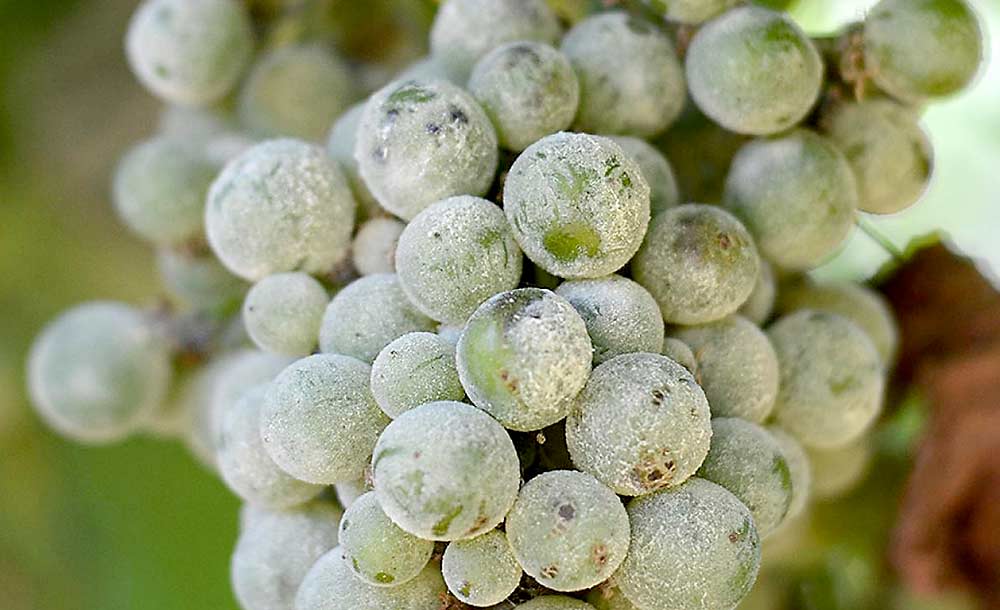
Grape powdery mildew has a new foe in an advanced technology that shuts down the mildew’s ability to infest grapes.
“The mildew is less likely to develop resistance against this technology compared to traditional fungicides, and it reduces the need for chemical fungicide applications,” said Mary Wildermuth, an associate professor of plant and microbial biology at the University of California, Berkeley who is studying how to “turn off” mildew’s mode of infection.
Primary funding for the project came from the American Vineyard Foundation (AVF) and the National Science Foundation. AVF chairman Tony Stephen said the organization “supports innovative grape and wine research and believes that Dr. Wildermuth’s work represents a pioneering technology that will allow wine grape growers to control powdery mildew with less reliance on fungicides.”
How it works

The technology used by the Wildermuth team effectively sabotages the production of certain proteins that allow the mildew to grow on plants. It works at the genetic level, interfering with the messenger ribonucleic acid, or mRNA, that the mildew needs in order to translate its DNA into specific proteins. This gives the technology its name: RNA interference, or RNAi. (Another term for this approach is spray-induced gene silencing.)
The researchers accomplished this task by using specially designed molecules known as double-stranded RNA, or dsRNA, that enter the mildew’s cells and convert into smaller molecules called small interfering RNAs, or siRNA. These siRNA bind to the targeted mildew mRNA — and only the targeted mRNA — and chop it into bits, which shuts down the protein-making pathway. In other words, “it takes advantage of a process that already exists in the powdery mildew,” Wildermuth said.
She and her research group have been studying the powdery mildew and host plant interaction for more than 15 years. In recent years, Wildermuth, assistant project scientist Jyoti Taneja and graduate student Amanda McRae (who recently completed her doctorate degree) sought to develop the spray-applied or topical RNAi technology for use against powdery mildew.
To get it to work, they first needed detailed knowledge of the powdery mildew’s genetic material. So, Wildermuth led an international collaborative effort with the Department of Energy Joint Genome Institute to obtain the genome sequences for 11 different powdery mildew species, each of which infests a different plant.
In parallel, her team conducted market analyses with the help of UC Berkeley’s Haas School of Business students and the National Science Foundation Innovation Corps customer/market discovery program, to help identify the powdery mildew in most need of attention.
The grape powdery mildew (Erysiphe necator) was clearly in need.
“Part of the reason for choosing this species is not only that California is the third-largest producer of wine grapes in the world … but also that 90 percent of the pesticide use for grapevines is to treat powdery mildew,” Wildermuth said. “And because we’re in California, and at UC Berkeley, we have excellent connections with the growers here, the UC extension system, the UC specialists and viticulture advisors. This allows us to understand the growers’ needs to make sure our approach is matched to their requirements.”
From there, the researchers tested the spray-applied RNAi approach against the same powdery mildew protein that is in the cross hairs of demethylase inhibitor (DMI) fungicides. The protein — a sterol demethylase — is critical to powdery mildew growth.
“DMI pesticides target this protein by binding to and inhibiting the protein, (and) mildews are developing resistance to DMI and other classes of chemical fungicides, limiting their efficacy and forcing growers to look for new solutions to limit powdery mildews,” Wildermuth said. “The topical RNAi approach, however, has a totally different mechanism of action against a target, and one that is less likely to result in the powdery mildew developing resistance against it.”
Lab to field
With that success under their belts, the researchers designed and tested siRNAs to disable several other target proteins as well, Taneja said. Their greenhouse tests have demonstrated that topical RNAi “clearly and strongly reduces powdery mildew disease compared to untreated plants,” she said.
Their priority now is to assess and optimize the technology in the field. Taneja estimated that the RNAi product could become available to growers in three to five years. That rollout can’t come soon enough, she said.
“This solves a need,” she said. “It adds a novel mode of action and solution to the grower’s toolbox.”
Countries in Europe and Asia are limiting the use of certain fungicides and employing more stringent requirements for maximum chemical residue levels left on the fruit.
“Our approach is compatible with these requirements because the designed dsRNA is specific to the powdery mildew target, RNA is a naturally occurring compound, and it is degraded through natural processes,” Wildermuth said.
Eventually, the researchers hope to expand their work to other species of powdery mildew, such as those that target roses, melons, squash, cherry and apple trees, Wildermuth said. For now, however, they are keeping their primary focus on grape powdery mildew.
“Topical RNAi should be an effective, durable and safer method to control powdery mildew, so I would encourage grape growers to continue talking to us so we can make it what they need,” she said. “I’ve been so impressed with the grape and wine industry and their openness to share information and work with us, because the more we know about the details of how things work in the field, the more we can ensure that our product is what they want.” •
—by Leslie Mertz






Leave A Comment